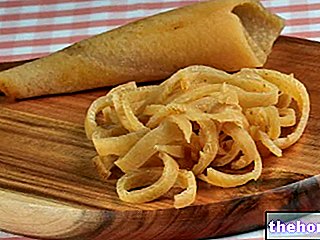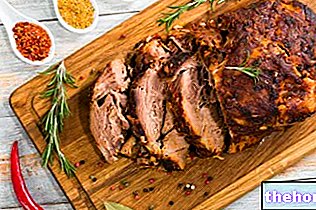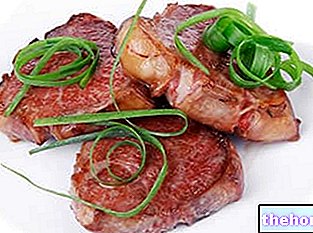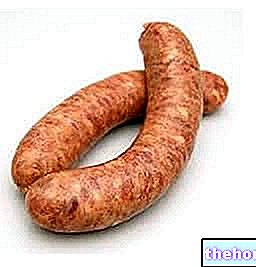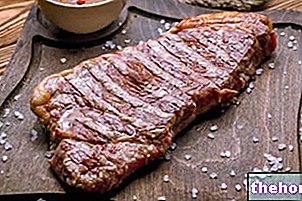
It has a rather tender consistency, a more intense taste than pork tenderloin but less strong than beef sirloin, a discrete nutritional profile and, compared to other muscles of the animal, a fair digestibility - which can vary according to the cooking method, the seasoning and the composition of the recipe or the overall meal.
A source of high biological value proteins, specific vitamins and minerals, the beef fillet belongs to the 1st fundamental group of foods. We must not forget that it is also a source of cholesterol and saturated fats, as well as purines and phenylalanine - molecules that can interfere with certain metabolic diseases. The percentage of fat depends on the breed, age and nutritional status of the animal.
Beef fillet is consumed almost all over the world.The types of cooking that are most interesting for this cut of meat are: roasted - baked or grilled or on a spit, natural or in crust, etc. - in a pan and frying etc. The fillet of beef is par excellence the cut of meat that can be cooked "rare"; in Italy it is often left attached to the bone, together with the sirloin or rib, in the cut of the Florentine steak - alter ego of the Anglo-Saxon T-bone. It is also excellent raw, in tartare or carpaccio, even if in circumstances of greater vulnerability - such as gestation - is generally not recommended.
with high biological value, specific vitamins and minerals.
It has a medium or high energy intake, depending on the breed, age and nutrition status of the animal. Calories are mainly provided by proteins, followed by lipids; carbohydrates are absent. The peptides have a high biological value, that is, they contain all the essential amino acids in the right quantities and proportions compared to the human model. Fatty acids are predominantly unsaturated, especially monounsaturated, followed almost equally by saturated ones; polyunsaturates make up the least significant portion. Cholesterol is present in significant but acceptable quantities.
Beef fillet does not contain dietary fiber, gluten, lactose and histamine. Instead, it has significant amounts of purines and phenylalanine amino acid.
From a vitamin point of view, the beef fillet is a food that does not stand out from the average of products belonging to the same category - meat. It mainly contains water-soluble vitamins of group B, in particular niacin (vit PP), pyridoxine (vit B6) and cobalamin (vit B12); thiamine (B1) and riboflavin (B2) are less relevant. Ascorbic acid (vitamin C) and all the fat-soluble acids (vit A, vit D, vit E, vit K) appear to be absent or irrelevant.
Also as regards the mineral salts, the beef fillet does not differ too much from its belonging group. The content of phosphorus, iron and zinc is appreciable; it also brings potassium.

Beef fillet, rich in high biological value proteins, is very useful in the diet of those who find themselves in a condition of increased need for all essential amino acids; for example: pregnancy and breastfeeding, growth, extremely intense and / or prolonged sporting practice, old age - for eating disorder and tendency to geriatric malabsorption - pathological malabsorption, recovery from specific or generalized malnutrition, defedation, etc.
For the reasonable content of cholesterol and the acceptable percentage of saturated fat, it can be used in the diet against hypercholesterolemia, provided that the portion and frequency of consumption are acceptable. Note: in dietary therapy against dyslipidemia it is however less appropriate compared to fish - finnuts proper - rich in omega 3 (EPA and DHA).
It is a neutral food for diets aimed at people suffering from hyperglycemia or type 2 diabetes mellitus, hypertriglyceridemia and hypertension.
Beef fillet is one of the products to avoid, or to consume in extreme moderation, in case of severe hyperuricemia - tendency to gout - and kidney stones or lithiasis caused by uric acid crystals. It should be completely removed from the diet for phenylketonuria. It shows no contraindications for lactose intolerance, histamine and celiac disease.
Beef fillet is an appreciable source of bioavailable iron and participates in covering metabolic needs, higher in fertile and pregnant women, marathon runners and vegetarians - especially vegans. Note: Iron deficiency can lead to iron deficiency anemia. Beef fillet contributes to meeting the needs of phosphorus, a very abundant mineral in the body - in particular in the bones in the form of hydroxyapatite, in the phospholipids of cell membranes and in the nervous tissue etc. The zinc content - essential for hormone production and enzymatic antioxidant - it is more than appreciable. Beef fillet is not to be considered an essential source of potassium, but it still participates in satisfying the body's demand - greater in case of increased sweating, for example in sports, increased diuresis and diarrhea ; the lack of this alkalizing ion - necessary for the membrane potential and very useful in the fight against primary arterial hypertension - induces, especially related to lack of magnesium and dehydration, the onset of muscle cramps and general weakness.
Beef fillet is very rich in B vitamins, all coenzyme factors of great importance in cellular processes. It can therefore be considered an excellent support for the functioning of the various body tissues.
It is not allowed in the vegetarian and vegan diet. It is inadequate for Hindu and Buddhist nutrition, while it has no contraindications in Muslim and Jewish ones.
After total cooking, it is also allowed in the diet during pregnancy.
The average portion of beef fillet is 100-150 g (about 150-225 kcal, up to 250-375 kcal).
and sausages.
Beef fillet lends itself to many different preparations. The modes of heat transmission can take advantage of conduction, convection and radiation; temperatures are almost always high and times generally low - the only exception being the specific method of cooking at low temperatures.
By virtue of its organoleptic and gustatory characteristics, it lends itself greatly to raw preparations such as tartar and carpaccio.
Among the most common cooking techniques and systems we mention: roast - baked, grilled and on the spit - sauteed - in a pan - and frying - in vegetable oil or animal fat.
Some famous recipes for fillet of beef are: fillet with pepper (green or pink), fillet in bread crust, fillet in salt crust, grilled fillet, fillet with balsamic vinegar, floured and fried strips of beef, beef carpaccio , carne salada, beef tartar, etc.
The food and wine pairing of beef fillet depends on the recipe and the ingredients that accompany it; generally red and structured wines are preferred such as: Chianti Classico, Rosso di Montalcino, Rosso Piceno, Valpollicella and Terre di Franciacorta Rosso.
or loin; it is also more tender.The scientific name of the fillet is "psoas"; each animal has two, one on each side / side. It is a muscle of the hindquarter of the animal. It has a sub-lumbar position - that is, it is placed inferiorly to the vertebrae - and, together with the iliacus, it belongs to the hypoaxial group. Note: The sub-lumbar muscles are not considered torso muscles. It determines the arching of the vertebral column and, more precisely, of the lumbosacral tract.
It is important to specify that the fillet is not the loin or sirloin, which is instead part of the lumbo-thoracic multifidus, one of the supralumbar epiaxials. Although very close, these two cuts of meat have very different characteristics. The two loins - one on each side / side - support the entire structure of the animal and participate intensely in maintaining posture, walking and running; on the other hand, the fillets - especially in farm animals - are never energetically stressed. Furthermore, iliopsoas and lumbo-thoracic multifidus have a percentage of connective tissue, but above all a very different distribution of the same; this is the main feature that determines the softness of the tenderloin compared to the sirloin.
Other Foods - Amatriciana Meat Lamb - Lamb Meat Duck - Duck Meat Pork Chop Florentine Steak Boiled Broth Raw Meat Red Meat White Meat Beef Horse Meat Rabbit Meat Pork Meat Vegetable Meat Lean Meat Sheep and Goat Meat Carpaccio Ribs Cotechino Cutlet Snails or land snails Pheasant and Pheasant meat Guinea fowl - Guinea fowl meat Pork fillet Chicken Hamburger Hot Dog Kebab Patè Chicken breast Turkey breast Chicken - Chicken meat Meatballs Porchetta Quail - Quail meat Ragù Sausage Game Zampone OTHER ARTICLES MEAT Categories Food Alcoholic Meat Cereals and derivatives Sweeteners Sweets Offal Fruit Dried fruit Milk and derivatives Legumes Oils and fats Fish and fishery products Salami Spices Vegetables Health recipes Appetizers Bread, Pizza and Brioche First courses Second courses Vegetables and Salads Sweets and Desserts Ice creams and sorbets Syrups, liqueurs and grappas Preparations of Basic ---- In the Kitchen with Leftovers Carnival Recipes Christmas Recipes Diet Recipes Light Recipes Women's Day, Mom, Dad Functional Recipes International Recipes Easter Recipes Recipes for Celiacs Recipes for Diabetics Recipes for Holidays Recipes for Valentine's Day Recipes for Vegetarians Recipes Protein Regional Recipes Vegan Recipes
